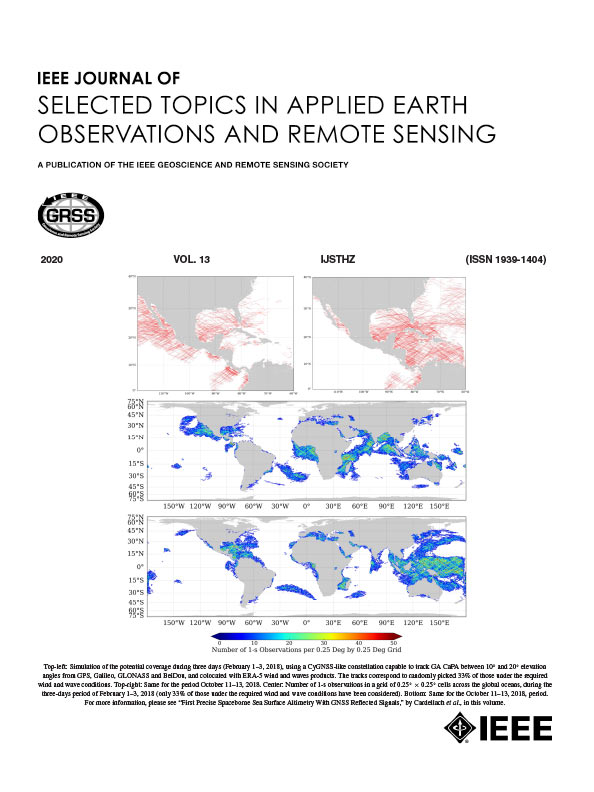高分辨率光学影像与时间序列SAR影像联合用于县级水稻种植区制图
IF 4.7
2区 地球科学
Q1 ENGINEERING, ELECTRICAL & ELECTRONIC
IEEE Journal of Selected Topics in Applied Earth Observations and Remote Sensing
Pub Date : 2025-04-14
DOI:10.1109/JSTARS.2025.3560992
引用次数: 0
摘要
及时、准确地绘制水稻空间分布图是确保粮食安全、管理水资源利用和优化农业生产的必要条件。水稻生长季节频繁的阴雨天气给利用光学图像构建综合时间序列特征带来了挑战。此外,县内农田地块的破碎化和稀疏化导致提取精度较低。针对上述挑战,本研究提出了一种基于高分辨率光学和时间序列合成孔径雷达(SAR)图像优势的多云和多雨地区县级水稻制图自动化框架。首先,建立HRTSNet模型,从GF-6高分辨率影像中提取农田地块;随后,利用Sentinel-1时间序列SAR数据,利用基于长短期记忆(LSTM)的时间分类模型获取包尺度水稻种植信息。该方法在中国的两个县进行了验证。结果表明,HRTSNet模型在高分辨率光学影像中提取农田地块时,mIoU最高,边界图与地面真实度最接近。该方法有效地将有限的GF-6图像与时间序列Sentinel-1数据相结合,并优于Random Forest和基于像素的传统机器学习算法,在当图县和如东县实现了超过88%的总体精度和超过86%的Kappa系数。此外,结合DPSVIm指数有效地提高了分类精度。研究结果为利用有限的光学影像进行县级水稻种植区制图提供了一种潜在的解决方案。本文章由计算机程序翻译,如有差异,请以英文原文为准。
Mapping County-Level Rice Planting Areas by Joint Use of High-Resolution Optical and Time Series SAR Imagery
Timely and accurate mapping of rice spatial distribution is needed for ensuring food security, managing water usage, and optimizing agricultural production. Frequent cloudy and rainy weather during the rice growing season presents challenges in constructing comprehensive time-series features from optical images. In addition, the fragmentation and sparsity of farmland parcels within the county lead to low extraction accuracy. To address the above challenges, this study proposed an automated rice mapping framework for county-level rice mapping in cloudy and rainy regions by integrating the strengths of high-resolution optical and time-series Synthetic Aperture Radar (SAR) imagery. First, the HRTSNet model was developed to extract farmland parcels from GF-6 high resolution imagery. Subsequently, the long short-term memory (LSTM)-based temporal classification model was utilized to acquire rice cultivation information at parcel scale using time-series Sentinel-1 SAR data. The proposed method was validated at two counties in China. The results showed that the HRTSNet model achieved the highest mIoU and delineated the closest boundary maps to ground truth in extracting farmland parcels from high-resolution optical imagery. And the proposed method effectively integrated limited GF-6 imagery with time-series Sentinel-1 data and performed better than traditional machine learning algorithms like Random Forest and pixel-based methods, achieving an overall accuracy of over 88% and a Kappa coefficient of over 86% for the Dangtu and Rudong counties. In addition, the classification accuracy was effectively improved by incorporating the DPSVIm index. The results provide a potential solution for mapping county-level rice planting areas with limited optical imagery.
求助全文
通过发布文献求助,成功后即可免费获取论文全文。
去求助
来源期刊
CiteScore
9.30
自引率
10.90%
发文量
563
审稿时长
4.7 months
期刊介绍:
The IEEE Journal of Selected Topics in Applied Earth Observations and Remote Sensing addresses the growing field of applications in Earth observations and remote sensing, and also provides a venue for the rapidly expanding special issues that are being sponsored by the IEEE Geosciences and Remote Sensing Society. The journal draws upon the experience of the highly successful “IEEE Transactions on Geoscience and Remote Sensing” and provide a complementary medium for the wide range of topics in applied earth observations. The ‘Applications’ areas encompasses the societal benefit areas of the Global Earth Observations Systems of Systems (GEOSS) program. Through deliberations over two years, ministers from 50 countries agreed to identify nine areas where Earth observation could positively impact the quality of life and health of their respective countries. Some of these are areas not traditionally addressed in the IEEE context. These include biodiversity, health and climate. Yet it is the skill sets of IEEE members, in areas such as observations, communications, computers, signal processing, standards and ocean engineering, that form the technical underpinnings of GEOSS. Thus, the Journal attracts a broad range of interests that serves both present members in new ways and expands the IEEE visibility into new areas.

 求助内容:
求助内容: 应助结果提醒方式:
应助结果提醒方式:


